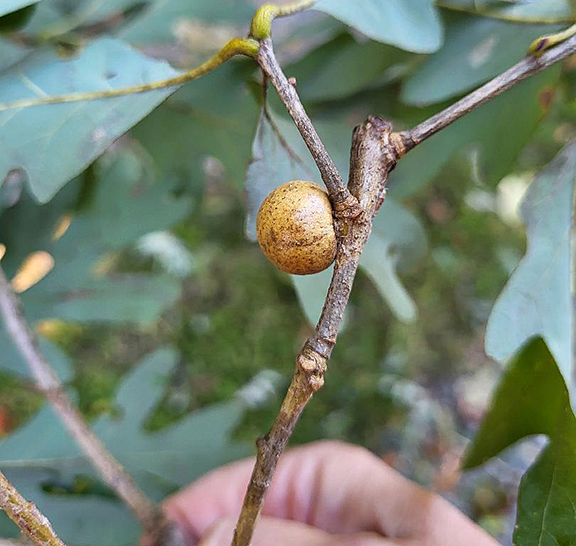Welcome!

Oak galls are a natural produce that even the Founding Fathers appreciated.
Oak gall, wasps and black ink
Take a look at the accompanying picture. I’ll bet you’ve seen a few of these as you’ve been out, raking the yard this season. Do you know what it is?
This is the oak gall, an interesting by-product of the yearly battle between the oak gall wasp and the oak tree. Another name for it is the round bullet gall. It is also called roly-poly gall because of its round, marble-like shape. It could be the reason why you noticed flagging on your oak trees in late summer.
Whatever you call it, the gall is caused by a little brown wasp. The bug lays its eggs in a dormant oak bud in November through January. As new growth begins in late winter or early spring, the egg hatches and the tree begins to form the gall around the insect to protect itself. Many gall wasps develop for 2 or 3 years in woody galls on the twigs of oaks.
According to a publication from the N.C. State Extension Entomology Insect Notes, “When these eggs hatch, and new growth resumes on the oak, salivary secretions of the gall wasp grub act as powerful plant growth regulators that force the tree to form the gall. Gall wasp galls typically have an outer wall, a spongy fiber layer and a hard, seedlike structure inside of which the gall wasp grub develops. Although gall wasp grubs have chewing mouthparts, they do not seem to chew plant tissue. Evidently the gall secretes nutrients that the grubs lap up.”
It's all this lapping and developing that results in the aforementioned flagging. As the gall develops in late summer, it’s not unusual for the twig to break. This causes a short section of the tip of the oak branch to droop. It may still be barely attached by the gall but the twig wilts and eventually falls. While it is still on the tree, especially in the cases of a large infestation, the oak tree can look like somebody took a weed-whacker to it.
Here's another interesting bit of trivia. The wasp eggs can develop without making a gall, apparently. These are male wasps. However, those that eventually hatch out of the bullet galls are all females which can reproduce asexually. Leave it up to the girls to get the job done on their own if need be.
While I generally find these little brown marbles around my oak, a different type of oak wasp makes what is called an oak apple — a larger, more papery looking gall. However, these are most often found on the leaves themselves and not the twig. These, by the way, shouldn’t be confused with the Cedar-apple rust galls that are caused by a fungus. The galls look a lot alike but they are totally different productions.
I gather these little marbles or bullets up as I find them to make a black ink. It’s pretty simple. You pulverize 18-24 oak galls to powder. Add the powder to about 12 ounces of water and boil. Let the water set overnight. Strain. Add a teaspoon of iron sulfate. This will turn the liquid from a murky brown to a lovely dark black. To thicken the end product, add gum Arabic. It’s hard to say exactly how much but I would start with a teaspoon and add more if you think your ink needs to be thickened more.
The end result is a great craft product that can be used for journaling or painting. As you use it, remember you’re making a connection with the past. This is the same stuff that Leonardo da Vinci, Beethoven and the signers of the Constitution used. It’s been suitable for use for hundreds of years. And, if it’s good enough for our Founding Fathers, it should be good enough for us.
